Risks in Relation to Adopting Airbnb Accommodation: The Role of Fear of COVID-19
Abstract
1. Introduction
2. Literature Review
2.1. Airbnb Theoretical Background
2.2. Risks
3. Hypotheses Development
3.1. Risks and the Intention to Adopt Airbnb
3.2. Risks and the Intention to Adopt Airbnb in the Light of the Fear of COVID-19
4. Materials and Methods
4.1. Research Model Overview
4.2. The Sample and Design
4.3. Measures
5. Results
5.1. Assessment of outer Measurement Model
5.2. Assessment of the Structural Model
6. Discussion
6.1. Airbnb Risks and Intention to Stay in Airbnb
6.2. Assessing the Moderating Effect
7. Conclusions and Recommendations
8. Limitations and Future Research
Author Contributions
Funding
Institutional Review Board Statement
Informed Consent Statement
Data Availability Statement
Conflicts of Interest
Appendix A
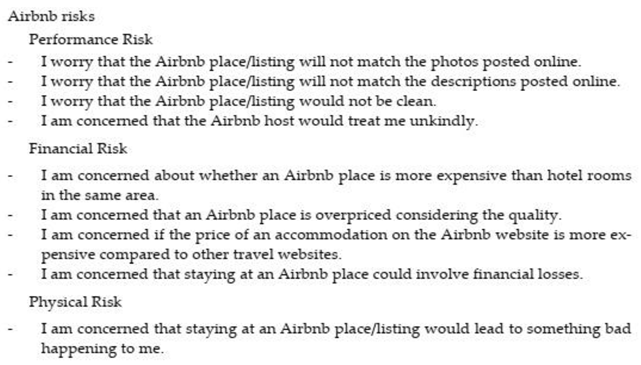

References
- Wachsmuth, D.; Weisler, A. Airbnb and the Rent Gap: Gentrification through the Sharing Economy. Environ. Plan. A Econ. Space 2018, 50, 1147–1170. [Google Scholar] [CrossRef]
- Amore, A.; de Bernardi, C.; Arvanitis, P. The Impacts of Airbnb in Athens, Lisbon and Milan: A Rent Gap Theory Perspective. Curr. Issues Tour. 2022, 25, 3329–3342. [Google Scholar] [CrossRef]
- Airbnb. Fast Facts. 2020. Available online: https://press.airbnb.com/fast-facts (accessed on 25 May 2020).
- Malhotra, A.; van Alstyne, M. The Dark Side of the Sharing Economy … and How to Lighten It. Commun. ACM 2014, 57, 24–27. [Google Scholar] [CrossRef]
- Chen, G.; Cheng, M.; Edwards, D.; Xu, L. COVID-19 Pandemic Exposes the Vulnerability of the Sharing Economy: A Novel Accounting Framework. J. Sustain. Tour. 2022, 30, 1141–1158. [Google Scholar] [CrossRef]
- Taylor, J.I. Airbnb hosts send 40Kþ letters to congress pleading for financial relief from coronavirus. Florida Politics (FLAPOL). Available online: https://floridapolitics.com/archives/324696-airbnb-hosts-send-40k-letters-to-congress-pleading-for-financial-relief-from-coronavirus (accessed on 26 August 2020).
- Hossain, M. The Effect of the COVID-19 on Sharing Economy Activities. J. Clean. Prod. 2021, 280, 124782. [Google Scholar] [CrossRef] [PubMed]
- Schimmenti, A.; Billieux, J.; Starcevic, V. The Four Horsemen of Fear: An Integrated Model of Understanding Fear Experiences during the COVID-19 Pandemic. Clin. Neuropsychiatry 2020, 17, 41. [Google Scholar] [PubMed]
- Yang, S.-B.; Lee, K.; Lee, H.; Koo, C. In Airbnb We Trust: Understanding Consumers’ Trust-Attachment Building Mechanisms in the Sharing Economy. Int. J. Hosp. Manag. 2019, 83, 198–209. [Google Scholar] [CrossRef]
- Lee, S.H. New Measuring Stick on Sharing Accommodation: Guest-Perceived Benefits and Risks. Int. J. Hosp. Manag. 2020, 87, 102471. [Google Scholar] [CrossRef]
- Mohamed, T. Airbnb IPO Could Be the ’Steal of the Century’ If People Keep Switching from Hotels to Homes, Jim Cramer says. Business Insider. Available online: https://news.yahoo.com/airbnb-ipo-could-steal-century-105012112.html (accessed on 26 August 2020).
- Kanwal, R. Impact of Perceived Risk on Consumer Purchase Intention towards Luxury Brands in Case of Pandemic: The Moderating Role of Fear. Int. Rev. Manag. Bus. Res. 2021, 10, 216–226. [Google Scholar] [CrossRef]
- Yi, J.; Yuan, G.; Yoo, C. The Effect of the Perceived Risk on the Adoption of the Sharing Economy in the Tourism Industry: The Case of Airbnb. Inf. Process. Manag. 2019, 57, 102108. [Google Scholar] [CrossRef]
- Tussyadiah, I.P. Factors of Satisfaction and Intention to Use Peer-to-Peer Accommodation. Int. J. Hosp. Manag. 2016, 55, 70–80. [Google Scholar] [CrossRef]
- Liang, L.J.; Choi, H.C.; Joppe, M. Understanding Repurchase Intention of Airbnb Consumers: Perceived Authenticity, Electronic Word-of-Mouth, and Price Sensitivity. J. Travel Tour. Mark. 2018, 35, 73–89. [Google Scholar] [CrossRef]
- Botsman, R. Defining the Sharing Economy: What Is Collaborative Consumption–and What Isn’t. Fast Company 2015, 27, 2015. [Google Scholar]
- Outdoorsy. Outdoorsy. 2023. Available online: https://www.outdoorsy.com/ (accessed on 28 August 2020).
- Airbnb. About Us. Available online: https://news.airbnb.com/about-us/ (accessed on 24 August 2020).
- Schor, J. Debating the Sharing Economy. A Great Transition Initiative Essay. 2014. Available online: https://greattransition.org/images/Schor-Debating-Sharing-Economy.pdf (accessed on 15 October 2021).
- Slee, T. Some Obvious Things about Internet Reputation Systems. Retrieved March 2023, 20, 2015. Available online: http://tomslee.net/2013/09/some-obvious-things-about-internet-reputation-systems.html (accessed on 15 October 2021).
- Guttentag, D. Progress on Airbnb: A Literature Review. J. Hosp. Tour. Technol. 2019, 10, 814–844. [Google Scholar] [CrossRef]
- Kuhzady, S.; Seyfi, S.; Béal, L. Peer-to-Peer (P2P) Accommodation in the Sharing Economy: A Review. Curr. Issues Tour. 2020, 25, 3115–3130. [Google Scholar] [CrossRef]
- Tajeddini, K.; Martin, E.; Ali, A. Enhancing Hospitality Business Performance: The Role of Entrepreneurial Orientation and Networking Ties in a Dynamic Environment. Int. J. Hosp. Manag. 2020, 90, 102605. [Google Scholar] [CrossRef] [PubMed]
- Zhu, Y.; Cheng, M.; Wang, J.; Ma, L.; Jiang, R. The Construction of Home Feeling by Airbnb Guests in the Sharing Economy: A Semantics Perspective. Ann. Tour. Res. 2019, 75, 308–321. [Google Scholar] [CrossRef]
- Tussyadiah, I.P. An Exploratory Study on Drivers and Deterrents of Collaborative Consumption in Travel. In Information and Communication Technologies in Tourism 2015; Springer International Publishing: Cham, Switzerland, 2015; pp. 817–830. [Google Scholar] [CrossRef]
- Guttentag, D. Airbnb: Disruptive Innovation and the Rise of an Informal Tourism Accommodation Sector. Curr. Issues Tour. 2015, 18, 1192–1217. [Google Scholar] [CrossRef]
- Zervas, G.; Proserpio, D.; Byers, J.W. The Rise of the Sharing Economy: Estimating the Impact of Airbnb on the Hotel Industry. J. Mark. Res. 2017, 54, 687–705. [Google Scholar] [CrossRef]
- Christensen, C.M. The Innovator’s Dilemma: When New Technologies Cause Great Firms to Fail; Harvard Business Review Press: Boston, MA, USA, 2013. [Google Scholar]
- Nguyen, Q. A Study of Airbnb as a Potential Competitor of the Hotel Industry. 2014. Available online: https://digitalscholarship.unlv.edu/thesesdissertations/2618 (accessed on 26 August 2020).
- Cheng, M.; Jin, X. What Do Airbnb Users Care about? An Analysis of Online Review Comments. Int. J. Hosp. Manag. 2019, 76, 58–70. [Google Scholar] [CrossRef]
- Guttentag, D.A.; Smith, S.L.J. Assessing Airbnb as a Disruptive Innovation Relative to Hotels: Substitution and Comparative Performance Expectations. Int. J. Hosp. Manag. 2017, 64, 1–10. [Google Scholar] [CrossRef]
- Quattrone, G.; Proserpio, D.; Quercia, D.; Capra, L.; Musolesi, M. Who Benefits from the “Sharing” Economy of Airbnb? In Proceedings of the 25th International Conference on World Wide Web, Montréal, QC, Canada, 11–15 April 2016; International World Wide Web Conferences Steering Committee: Geneva, Switzerland, 2016; pp. 1385–1394. [Google Scholar] [CrossRef]
- Elshaer, I.A.; Azazz, A.M.S.; Ameen, F.A.; Fayyad, S. Agritourism and Peer-to-Peer Accommodation: A Moderated Mediation Model. Agriculture 2022, 12, 1586. [Google Scholar] [CrossRef]
- Bang Nong, N.; Ha, V.H.T. Retracted Article: Impact of COVID-19 on Airbnb: Evidence from Vietnam. J. Sustain. Financ. Invest. 2023, 13, 283–296. [Google Scholar] [CrossRef]
- Heo, C.Y.; Blal, I.; Choi, M. What Is Happening in Paris? Airbnb, Hotels, and the Parisian Market: A Case Study. Tour. Manag. 2019, 70, 78–88. [Google Scholar] [CrossRef]
- Young, C.A.; Corsun, D.L.; Xie, K.L. Travelers’ Preferences for Peer-to-Peer (P2P) Accommodations and Hotels. Int. J. Cult. Tour. Hosp. Res. 2017, 11, 465–482. [Google Scholar] [CrossRef]
- Truong, A. Why the Hotel Industry Isn’t Afraid of Airbnb (Yet), Explained in Five Charts. Quartz. Available online: https://qz.com/551612/why-the-hotelindustry-isnt-afraid-of-airbnb-yet-explained-in-five-charts/ (accessed on 26 August 2020).
- Kim. Understanding Key Antecedents of Consumer Loyalty toward Sharing-Economy Platforms: The Case of Airbnb. Sustainability 2019, 11, 5195. [Google Scholar] [CrossRef]
- Tajeddini, K.; Mostafa Rasoolimanesh, S.; Chathurika Gamage, T.; Martin, E. Exploring the Visitors’ Decision-Making Process for Airbnb and Hotel Accommodations Using Value-Attitude-Behavior and Theory of Planned Behavior. Int. J. Hosp. Manag. 2021, 96, 102950. [Google Scholar] [CrossRef]
- Lutz, C.; Hoffmann, C.P.; Bucher, E.; Fieseler, C. The Role of Privacy Concerns in the Sharing Economy. Inf. Commun. Soc. 2018, 21, 1472–1492. [Google Scholar] [CrossRef]
- Fuchs, G.; Reichel, A. An Exploratory Inquiry into Destination Risk Perceptions and Risk Reduction Strategies of First Time vs. Repeat Visitors to a Highly Volatile Destination. Tour. Manag. 2011, 32, 266–276. [Google Scholar] [CrossRef]
- Jun, S.H.; Vogt, C.A.; MacKay, K.J. Online Information Search Strategies: A Focus On Flights and Accommodations. J. Travel Tour. Mark. 2010, 27, 579–595. [Google Scholar] [CrossRef]
- Laroche, M.; McDougall, G.H.G.; Bergeron, J.; Yang, Z. Exploring How Intangibility Affects Perceived Risk. J. Serv. Res. 2004, 6, 373–389. [Google Scholar] [CrossRef]
- So, K.K.F.; Oh, H.; Min, S. Motivations and Constraints of Airbnb Consumers: Findings from a Mixed-Methods Approach. Tour. Manag. 2018, 67, 224–236. [Google Scholar] [CrossRef]
- Wang, C.; Jeong, M. What Makes You Choose Airbnb Again? An Examination of Users’ Perceptions toward the Website and Their Stay. Int. J. Hosp. Manag. 2018, 74, 162–170. [Google Scholar] [CrossRef]
- Grewal, D.; Iyer, G.R.; Gotlieb, J.; Levy, M. Developing a Deeper Understanding of Post-Purchase Perceived Risk and Behavioral Intentions in a Service Setting. J. Acad. Mark. Sci. 2007, 35, 250–258. [Google Scholar] [CrossRef]
- Villacé-Molinero, T.; Fernández-Muñoz, J.J.; Orea-Giner, A.; Fuentes-Moraleda, L. Understanding the New Post-COVID-19 Risk Scenario: Outlooks and Challenges for a New Era of Tourism. Tour. Manag. 2021, 86, 104324. [Google Scholar] [CrossRef] [PubMed]
- Park, S.; Tussyadiah, I.P.; Zhang, Y. Assessment of Perceived Risk in Mobile Travel Booking. In Information and Communication Technologies in Tourism 2016; Springer International Publishing: Cham, Switzerland, 2016; pp. 467–480. [Google Scholar] [CrossRef]
- Cunningham, M.S. The Major Dimensions of Perceived Risk. Risk Taking and Information Handling in Consumer Behavior. J. Serv. Sci. Manag. 2015, 8, 82–108. [Google Scholar]
- Birkel, H.; Veile, J.; Müller, J.; Hartmann, E.; Voigt, K.-I. Development of a Risk Framework for Industry 4.0 in the Context of Sustainability for Established Manufacturers. Sustainability 2019, 11, 384. [Google Scholar] [CrossRef]
- Lee, M.-C. Predicting and Explaining the Adoption of Online Trading: An Empirical Study in Taiwan. Decis. Support. Syst. 2009, 47, 133–142. [Google Scholar] [CrossRef]
- Lee, C.-K.; Song, H.-J.; Bendle, L.J.; Kim, M.-J.; Han, H. The Impact of Non-Pharmaceutical Interventions for 2009 H1N1 Influenza on Travel Intentions: A Model of Goal-Directed Behavior. Tour. Manag. 2012, 33, 89–99. [Google Scholar] [CrossRef]
- Song, H.-J.; Lee, C.-K.; Norman, W.C.; Han, H. The Role of Responsible Gambling Strategy in Forming Behavioral Intention. J. Travel. Res. 2012, 51, 512–523. [Google Scholar] [CrossRef]
- Song, H.J.; Lee, C.-K.; Kang, S.K.; Boo, S. The Effect of Environmentally Friendly Perceptions on Festival Visitors’ Decision-Making Process Using an Extended Model of Goal-Directed Behavior. Tour. Manag. 2012, 33, 1417–1428. [Google Scholar] [CrossRef]
- Lee, S.; Bruwer, J.; Song, H. Experiential and Involvement Effects on the Korean Wine Tourist’s Decision-Making Process. Curr. Issues Tour. 2017, 20, 1215–1231. [Google Scholar] [CrossRef]
- Ert, E.; Fleischer, A.; Magen, N. Trust and Reputation in the Sharing Economy: The Role of Personal Photos in Airbnb. Tour. Manag. 2016, 55, 62–73. [Google Scholar] [CrossRef]
- van Holm, E.J. Evaluating the Impact of Short-Term Rental Regulations on Airbnb in New Orleans. Cities 2020, 104, 102803. [Google Scholar] [CrossRef]
- Boshoff, C. Service Advertising. J. Serv. Res. 2002, 4, 290–298. [Google Scholar] [CrossRef]
- Cunningham, L.F.; Gerlach, J.H.; Harper, M.D.; Young, C.E. Perceived Risk and the Consumer Buying Process: Internet Airline Reservations. Int. J. Serv. Ind. Manag. 2005, 16, 357–372. [Google Scholar] [CrossRef]
- Sun, J. How Risky Are Services? An Empirical Investigation on the Antecedents and Consequences of Perceived Risk for Hotel Service. Int. J. Hosp. Manag. 2014, 37, 171–179. [Google Scholar] [CrossRef]
- Sirakaya, E.; Woodside, A.G. Building and Testing Theories of Decision Making by Travellers. Tour. Manag. 2005, 26, 815–832. [Google Scholar] [CrossRef]
- Quintal, V.A.; Lee, J.A.; Soutar, G.N. Risk, Uncertainty and the Theory of Planned Behavior: A Tourism Example. Tour. Manag. 2010, 31, 797–805. [Google Scholar] [CrossRef]
- Jacoby, J.; Kaplan, L.B. The components of perceived risk. In Proceedings of the 3rd Annual Conference of the Association for Consumer Research, Chicago, IL, USA, 3–5 November 1972; pp. 382–393. [Google Scholar]
- Xie, K.; Mao, Z. The Impacts of Quality and Quantity Attributes of Airbnb Hosts on Listing Performance. Int. J. Contemp. Hosp. Manag. 2017, 29, 2240–2260. [Google Scholar] [CrossRef]
- Gefen, D.; Pavlou, P.A. The Boundaries of Trust and Risk: The Quadratic Moderating Role of Institutional Structures. Inf. Syst. Res. 2012, 23, 940–959. [Google Scholar] [CrossRef]
- Horton, R.L. The Structure of Perceived Risk: Some Further Progress. J. Acad. Mark. Sci. 1976, 4, 694–706. [Google Scholar] [CrossRef]
- Finley, K. Finley, K. Trust in the Sharing Economy: An Exploratory Study. Master’s Thesis, The University of Warwick, Warwickshire, UK, 2013. [Google Scholar]
- Garner, S.J. Perceived Risk and Information Sources in Services Purchasing. Mid-Atl. J. Bus. 1986, 24, 49–58. [Google Scholar]
- Franzoni, S.; Pelizzari, C. Rainfall Financial Risk Assessment in the Hospitality Industry. Int. J. Contemp. Hosp. Manag. 2019, 31, 1104–1121. [Google Scholar] [CrossRef]
- Quan, L.; Al-Ansi, A.; Han, H. Assessing Customer Financial Risk Perception and Attitude in the Hotel Industry: Exploring the Role of Protective Measures against COVID-19. Int. J. Hosp. Manag. 2022, 101, 103123. [Google Scholar] [CrossRef]
- Lieber, R. Airbnb Horror Story Points to Need for Precautions. Available online: http://www.nytimes.com/2015/08/15/your-money/airbnb-horror-story-points-to-need-for-precautions.html?_r=1 (accessed on 6 June 2016).
- Jose, M.L. First, Listen to My Story of Being Drugged on an Airbnb Stay, then Learn From It. Available online: http://matadornetwork.com/trips/drugged-and-terrified-an-airbnb-booking-gonewrong/ (accessed on 6 June 2016).
- Hill, K. After a Woman Was Poisoned in an Airbnb, the Company Started Giving out Prevention Devices. 2015. Available online: http://fusion.net/story/229589/airbnb-death-safety-regulations/ (accessed on 4 August 2016).
- Jun, S.-H. The Effects of Perceived Risk, Brand Credibility and Past Experience on Purchase Intention in the Airbnb Context. Sustainability 2020, 12, 5212. [Google Scholar] [CrossRef]
- Pires, G.; Stanton, J.; Eckford, A. Influences on the Perceived Risk of Purchasing Online. J. Consum. Behav. 2004, 4, 118–131. [Google Scholar] [CrossRef]
- Hirunyawipada, T.; Paswan, A.K. Consumer Innovativeness and Perceived Risk: Implications for High Technology Product Adoption. J. Consum. Mark. 2006, 23, 182–198. [Google Scholar] [CrossRef]
- Wang, X.; Wang, H. How to Survive Mistreatment by Customers. Int. J. Confl. Manag. 2017, 28, 464–482. [Google Scholar] [CrossRef]
- Aqueveque, C. Extrinsic Cues and Perceived Risk: The Influence of Consumption Situation. J. Consum. Mark. 2006, 23, 237–247. [Google Scholar] [CrossRef]
- Mitchell, V.-W.; Greatorex, M. Risk Perception and Reduction in the Purchase of Consumer Services. Serv. Ind. J. 1993, 13, 179–200. [Google Scholar] [CrossRef]
- Hwang, J.; Choe, J.Y. Exploring Perceived Risk in Building Successful Drone Food Delivery Services. Int. J. Contemp. Hosp. Manag. 2019. ahead-of-print. [Google Scholar] [CrossRef]
- Porges, S. Dear Would-Be Airbnb Guests: Here’s Why Hosts Keep Turning You Down. Last Modif. Jan. 2016, 18, 2016. [Google Scholar]
- Karlsson, L.; Kemperman, A.; Dolnicar, S. May I Sleep in Your Bed? Getting Permission to Book. Ann. Tour. Res. 2017, 62, 1–12. [Google Scholar] [CrossRef]
- Elshaer, I.A.; Azazz, A.M.S.; Ameen, F.A.; Fayyad, S. Sustainable Horticulture Practices to Predict Consumer Attitudes towards Green Hotel Visit Intention: Moderating the Role of an Environmental Gardening Identity. Horticulturae 2022, 9, 31. [Google Scholar] [CrossRef]
- Radic, A.; Law, R.; Lück, M.; Kang, H.; Ariza-Montes, A.; Arjona-Fuentes, J.M.; Han, H. Apocalypse Now or Overreaction to Coronavirus: The Global Cruise Tourism Industry Crisis. Sustainability 2020, 12, 6968. [Google Scholar] [CrossRef]
- Nguyen, H.M.; Phuc, H.N.; Tam, D.T. Travel Intention Determinants during COVID-19: The Role of Trust in Government Performance. J. Innov. Knowl. 2023, 8, 100341. [Google Scholar] [CrossRef]
- Pavlou, P.A.; Gefen, D. Building Effective Online Marketplaces with Institution-Based Trust. Inf. Syst. Res. 2004, 15, 37–59. [Google Scholar] [CrossRef]
- Elshaer, I.A.; Azazz, A.M.S.; Fayyad, S. Positive Humor and Work Withdrawal Behaviors: The Role of Stress Coping Styles in the Hotel Industry Amid COVID-19 Pandemic. Int. J. Environ. Res. Public Health 2022, 19, 6233. [Google Scholar] [CrossRef]
- Skard, S.; Nysveen, H. Trusting Beliefs and Loyalty in B-to-B Self-Services. J. Bus.-Bus. Mark. 2016, 23, 257–276. [Google Scholar] [CrossRef]
- Dean, J.W.; Sharfman, M.P. The Relationship between Procedural Rationality and Political Behavior in Strategic Decision Making. Decis. Sci. 1993, 24, 1069–1083. [Google Scholar] [CrossRef]
- Lee, S.H.; Deale, C. Consumers’ Perceptions of Risks Associated with the Use of Airbnb before and during the COVID-19 Pandemic. Int. Hosp. Rev. 2021, 35, 225–239. [Google Scholar] [CrossRef]
- Khurana, S.; Haleem, A.; Luthra, S.; Huisingh, D.; Mannan, B. Now Is the Time to Press the Reset Button: Helping India’s Companies to Become More Resilient and Effective in Overcoming the Impacts of COVID-19, Climate Changes and Other Crises. J. Clean. Prod. 2021, 280, 124466. [Google Scholar] [CrossRef]
- Oh, S.-H.; Paek, H.-J.; Hove, T. Cognitive and Emotional Dimensions of Perceived Risk Characteristics, Genre-Specific Media Effects, and Risk Perceptions: The Case of H1N1 Influenza in South Korea. Asian J. Commun. 2015, 25, 14–32. [Google Scholar] [CrossRef]
- Weber, E.U. Experience-Based and Description-Based Perceptions of Long-Term Risk: Why Global Warming Does Not Scare Us (Yet). Clim. Chang. 2006, 77, 103–120. [Google Scholar] [CrossRef]
- Zheng, D.; Luo, Q.; Ritchie, B.W. The Role of Trust in Mitigating Perceived Threat, Fear, and Travel Avoidance after a Pandemic Outbreak: A Multigroup Analysis. J. Travel. Res. 2022, 61, 581–596. [Google Scholar] [CrossRef]
- Elshaer, I.A.; AboAlkhair, A.M.; Fayyad, S.; Azazz, A.M.S. Post-COVID-19 Family Micro-Business Resources and Agritourism Performance: A Two-Mediated Moderated Quantitative-Based Model with a PLS-SEM Data Analysis Method. Mathematics 2023, 11, 359. [Google Scholar] [CrossRef]
- Sharma, P.; Chan, R.Y.K.; Davcik, N.; Ueno, A. Cultural Differences in Deliberate Counterfeit Purchase Behavior. Mark. Intell. Plan. 2022, 40, 121–137. [Google Scholar] [CrossRef]
- Chen, H.S.; Chen, Y.; He, Y. Does Terrorism Impact on the Peer-to-Peer Accommodation Market? Empirical Evidence from Airbnb in Paris. Curr. Issues Tour. 2021, 24, 1781–1791. [Google Scholar] [CrossRef]
- Bagrowski, B.; Gutowska, J. Sleep Quality and the Level of Perceived Stress in Medical Students. Rocz. Psychol. 2022, 25, 87–98. [Google Scholar] [CrossRef]
- Chen, C.-C.; Chang, Y.-C. What Drives Purchase Intention on Airbnb? Perspectives of Consumer Reviews, Information Quality, and Media Richness. Telemat. Inform. 2018, 35, 1512–1523. [Google Scholar] [CrossRef]
- Ahorsu, D.K.; Lin, C.-Y.; Imani, V.; Saffari, M.; Griffiths, M.D.; Pakpour, A.H. The Fear of COVID-19 Scale: Development and Initial Validation. Int. J. Ment. Health Addict. 2020, 20, 1537–1545. [Google Scholar] [CrossRef] [PubMed]
- Leguina, A. A Primer on Partial Least Squares Structural Equation Modeling (PLS-SEM). Int. J. Res. Method Educ. 2015, 38, 220–221. [Google Scholar] [CrossRef]
- Henseler, J.; Ringle, C.M.; Sinkovics, R.R. The Use of Partial Least Squares Path Modeling in International Marketing. In Advances in International Marketing; Sinkovics, R.R., Ghauri, P.N., Eds.; Emerald Group Publishing Limited: Bentley, UK, 2009; Volume 20, pp. 277–319. [Google Scholar] [CrossRef]
- Elshaer, I.A.; Azazz, A.M.S.; Fayyad, S. Authenticity, Involvement, and Nostalgia in Heritage Hotels in the Era of Digital Technology: A Moderated Meditation Model. Int. J. Environ. Res. Public Health 2022, 19, 5784. [Google Scholar] [CrossRef] [PubMed]
- Gold, A.H.; Malhotra, A.; Segars, A.H. Knowledge Management: An Organizational Capabilities Perspective. J. Manag. Inf. Syst. 2001, 18, 185–214. [Google Scholar] [CrossRef]
- Hair Jr, J.F.; Hult, G.T.M.; Ringle, C.; Sarstedt, M. A Primer on Partial Least Squares Structural Equation Modeling (PLS-SEM); Sage Publications: Sauzend Oaks, CA, USA, 2016. [Google Scholar]
- Elshaer, I.A.; Azazz, A.M.S.; Fayyad, S. Green Management and Sustainable Performance of Small- and Medium-Sized Hospitality Businesses: Moderating the Role of an Employee’s Pro-Environmental Behaviour. Int. J. Environ. Res. Public Health 2023, 20, 2244. [Google Scholar] [CrossRef] [PubMed]
- Chin, W.W. The Partial Least Squares Approach for Structural Equation Modeling. Mod. Methods Bus. Res. 1998, 295, 295–336. [Google Scholar]
- Elshaer, I.A.; Azazz, A.M.S.; Fayyad, S. Green Human Resources and Innovative Performance in Small- and Medium-Sized Tourism Enterprises: A Mediation Model Using PLS-SEM Data Analysis. Mathematics 2023, 11, 711. [Google Scholar] [CrossRef]
- Havlena, W.J.; DeSarbo, W.S. On the Measurement of Perceived Consumer Risk. Decis. Sci. 1991, 22, 927–939. [Google Scholar] [CrossRef]
- Nepomuceno, M.V.; Laroche, M.; Richard, M.-O. How to Reduce Perceived Risk When Buying Online: The Interactions between Intangibility, Product Knowledge, Brand Familiarity, Privacy and Security Concerns. J. Retail. Consum. Serv. 2014, 21, 619–629. [Google Scholar] [CrossRef]
- Loh, E.G.Y.; Stephenson, M.L.; Nezakati, H. Constructing a Methodological Approach to Examine the Determinants Affecting Purchase Intention through Perceived Risk in the Hotel Context. J. Mark. Manag. Consum. Behav. 2021, 3, 1734. [Google Scholar]
- Li, J.; Moreno, A.; Zhang, D.J. Agent Behavior in the Sharing Economy: Evidence from Airbnb. Ross Sch. Bus. Work. Pap. Ser. 2015, 1298, 10–2139. [Google Scholar] [CrossRef]
- Wang, Y.; Asaad, Y.; Filieri, R. What Makes Hosts Trust Airbnb? Antecedents of Hosts’ Trust toward Airbnb and Its Impact on Continuance Intention. J. Travel. Res. 2020, 59, 686–703. [Google Scholar] [CrossRef]
- Mohsin, A.; Lengler, J. Airbnb Hospitality: Exploring Users and Non-Users’ Perceptions and Intentions. Sustainability 2021, 13, 10884. [Google Scholar] [CrossRef]
- Kahneman, D.; Tversky, A. On the Interpretation of Intuitive Probability: A Reply to Jonathan Cohen. Cognition 1979, 7, 409–411. [Google Scholar] [CrossRef]
- Camerer, C. Three Cheers--Psychological, Theoretical, Empirical--For Loss Aversion. J. Mark. Res. 2005, 42, 129–133. [Google Scholar] [CrossRef]
- Kock, F.; Nørfelt, A.; Josiassen, A.; Assaf, A.G.; Tsionas, M.G. Understanding the COVID-19 Tourist Psyche: The Evolutionary Tourism Paradigm. Ann. Tour. Res. 2020, 85, 103053. [Google Scholar] [CrossRef]
- Dubin, A. Which Is Safer: Airbnb or Hotels? Here’s What Doctors Say. Business Inside. Available online: https://www.businessinsider.com/which-is-safer-airbnb-hotels-coronavirus (accessed on 28 August 2020).
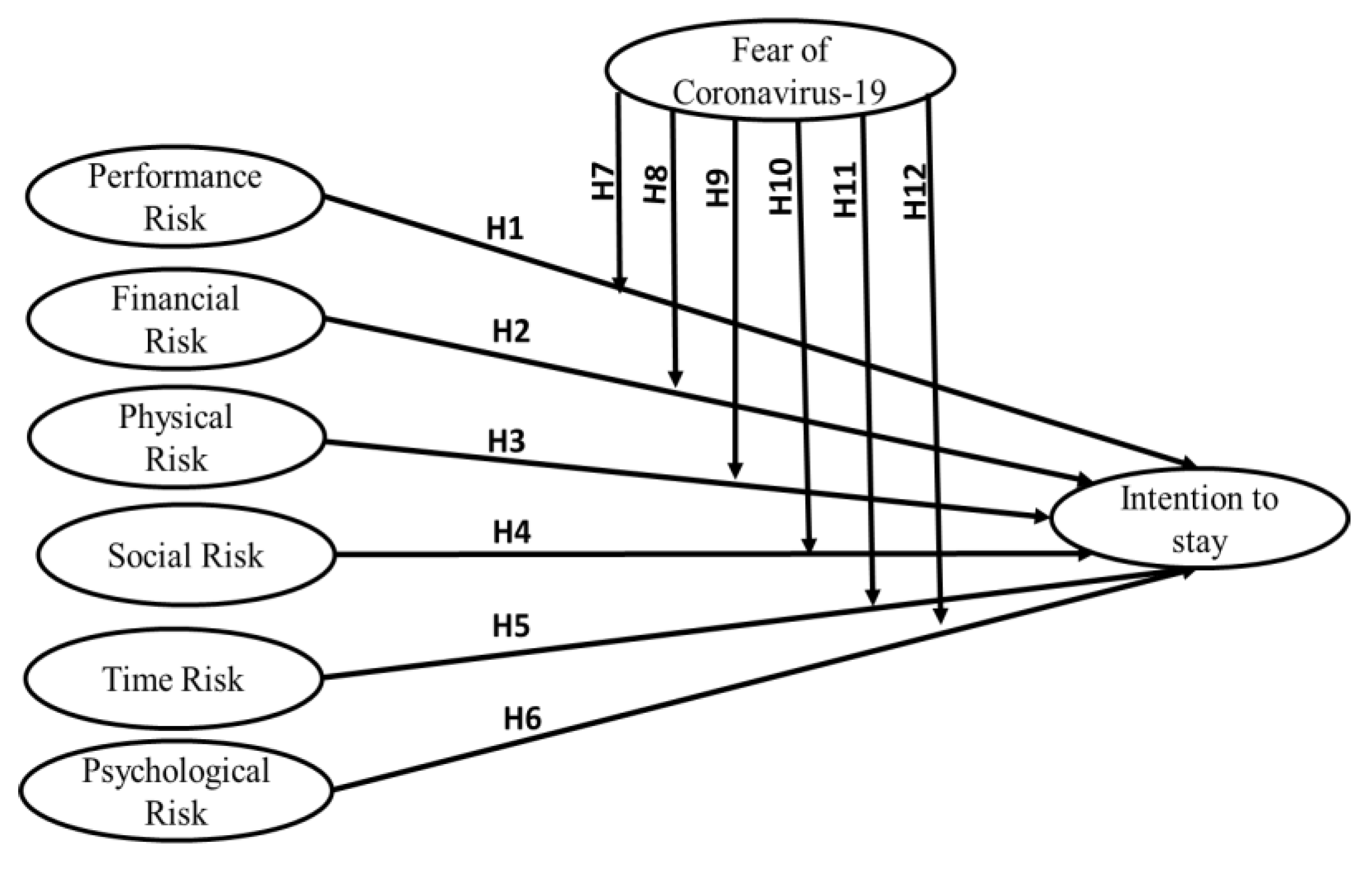
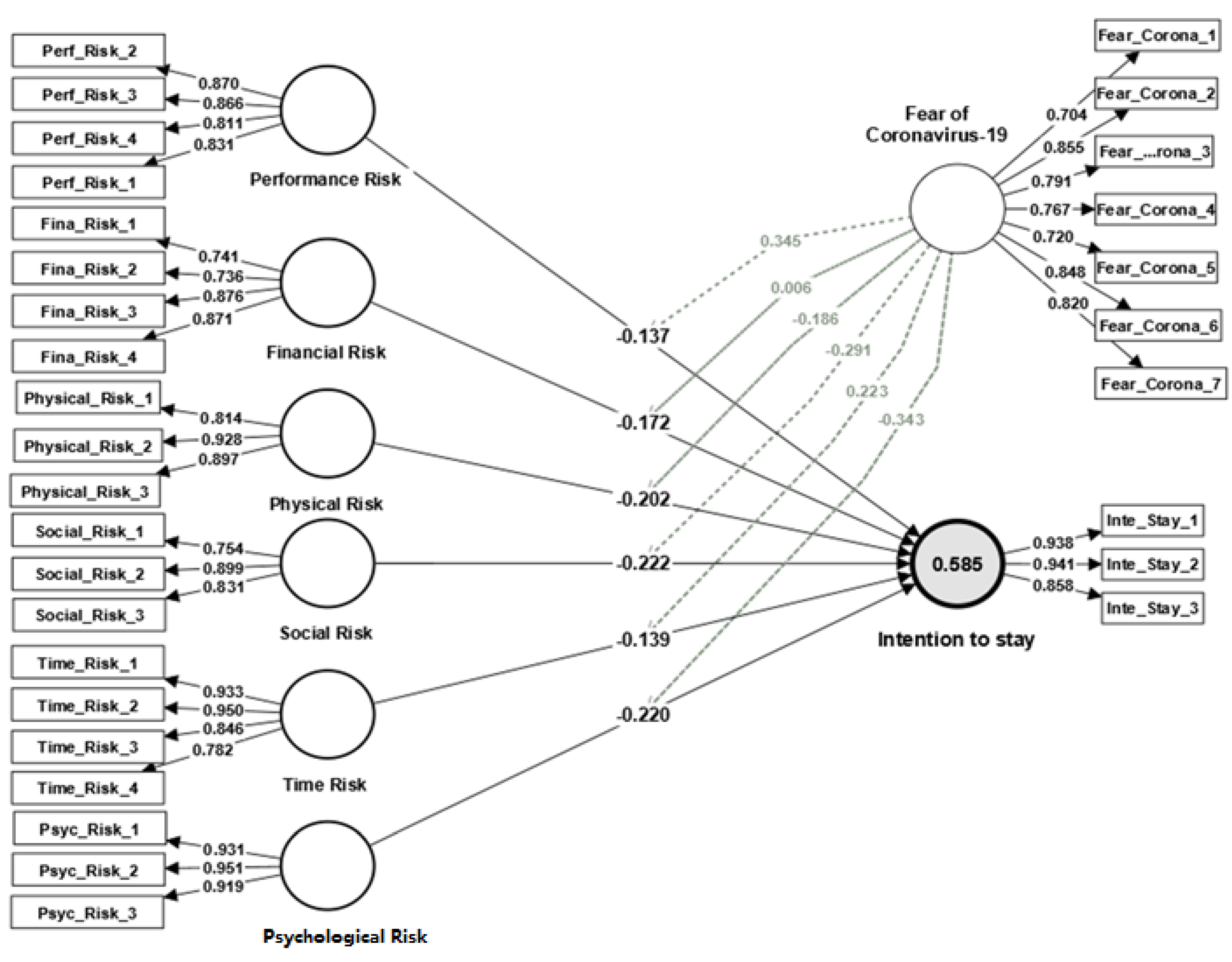
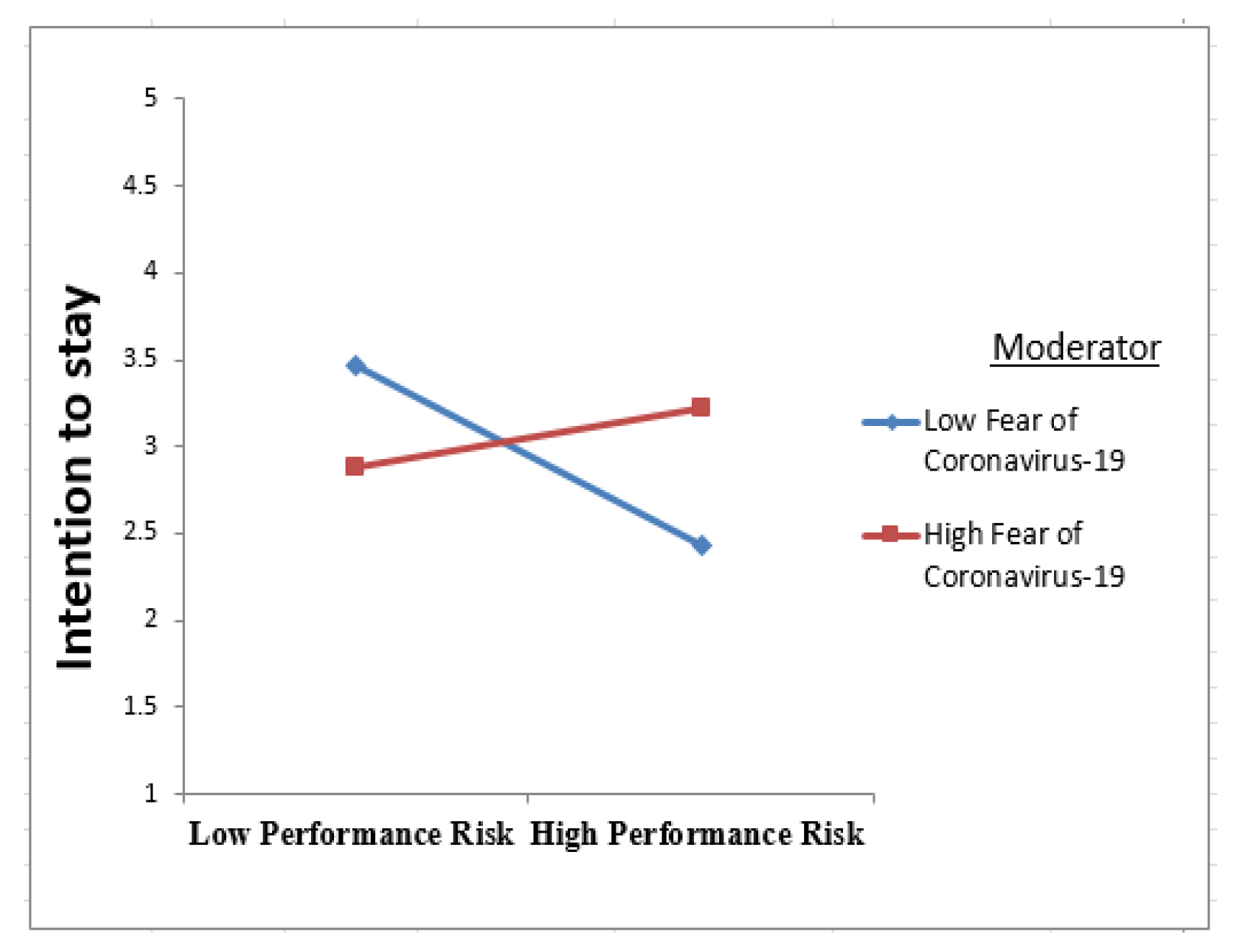
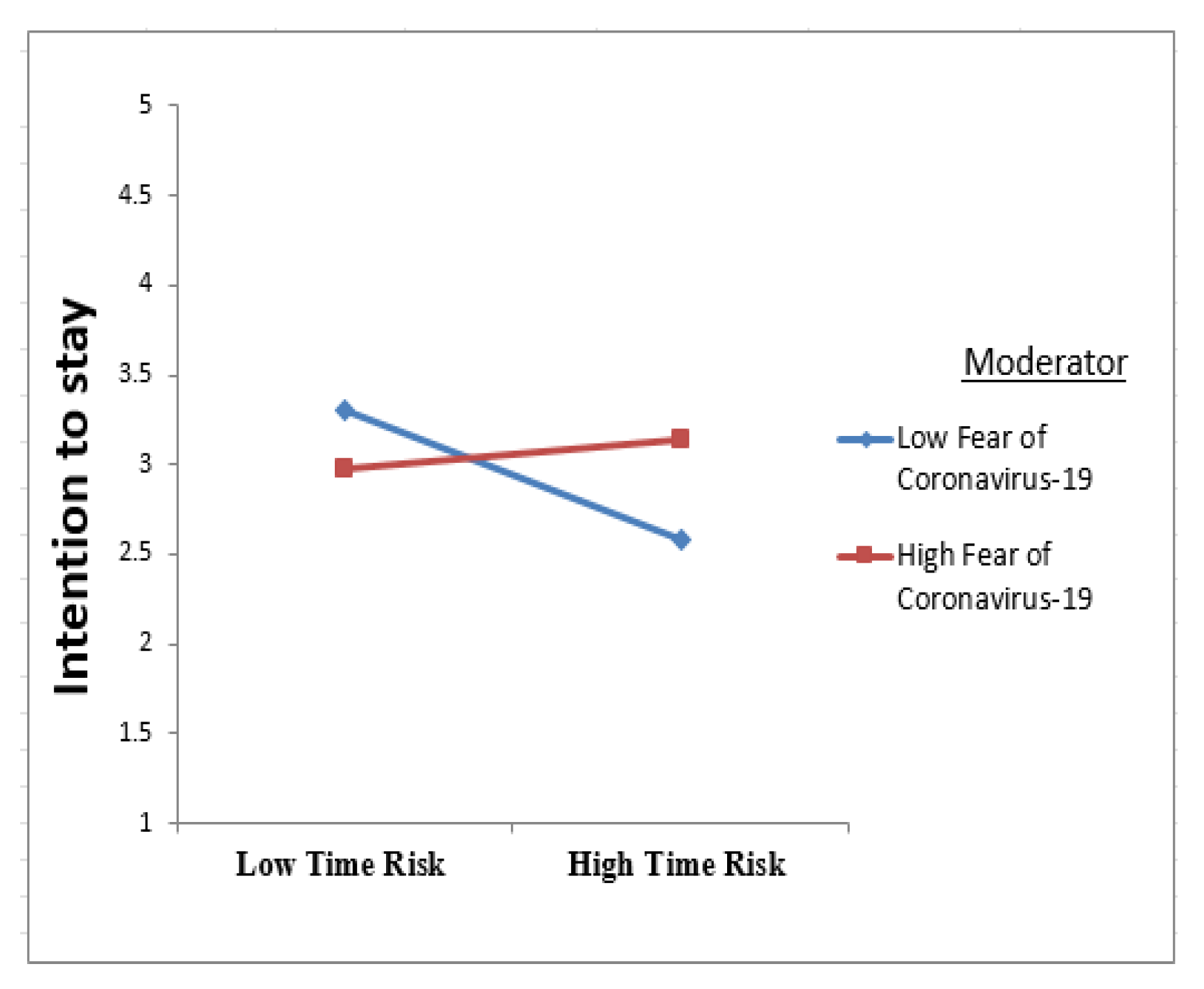
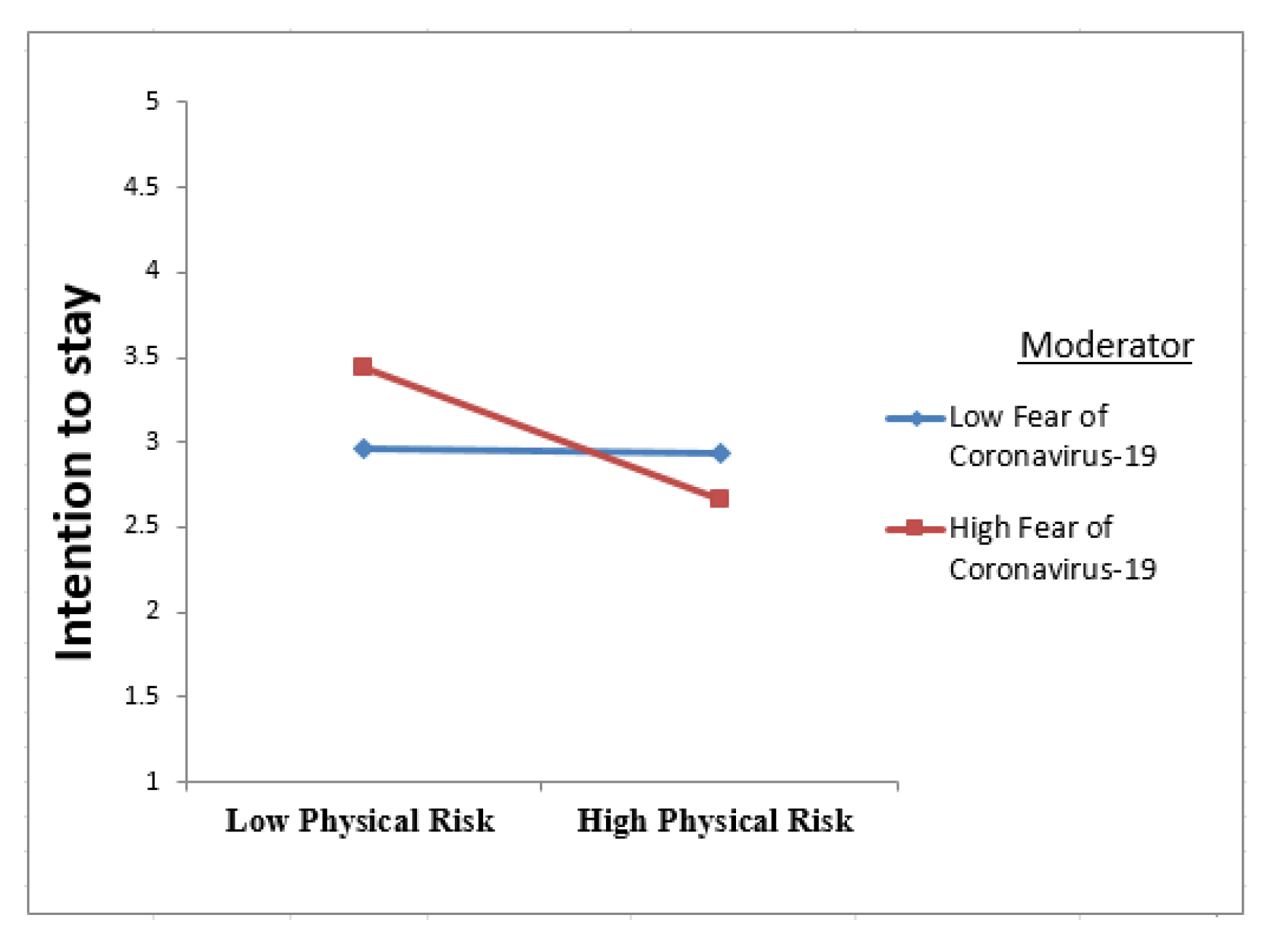
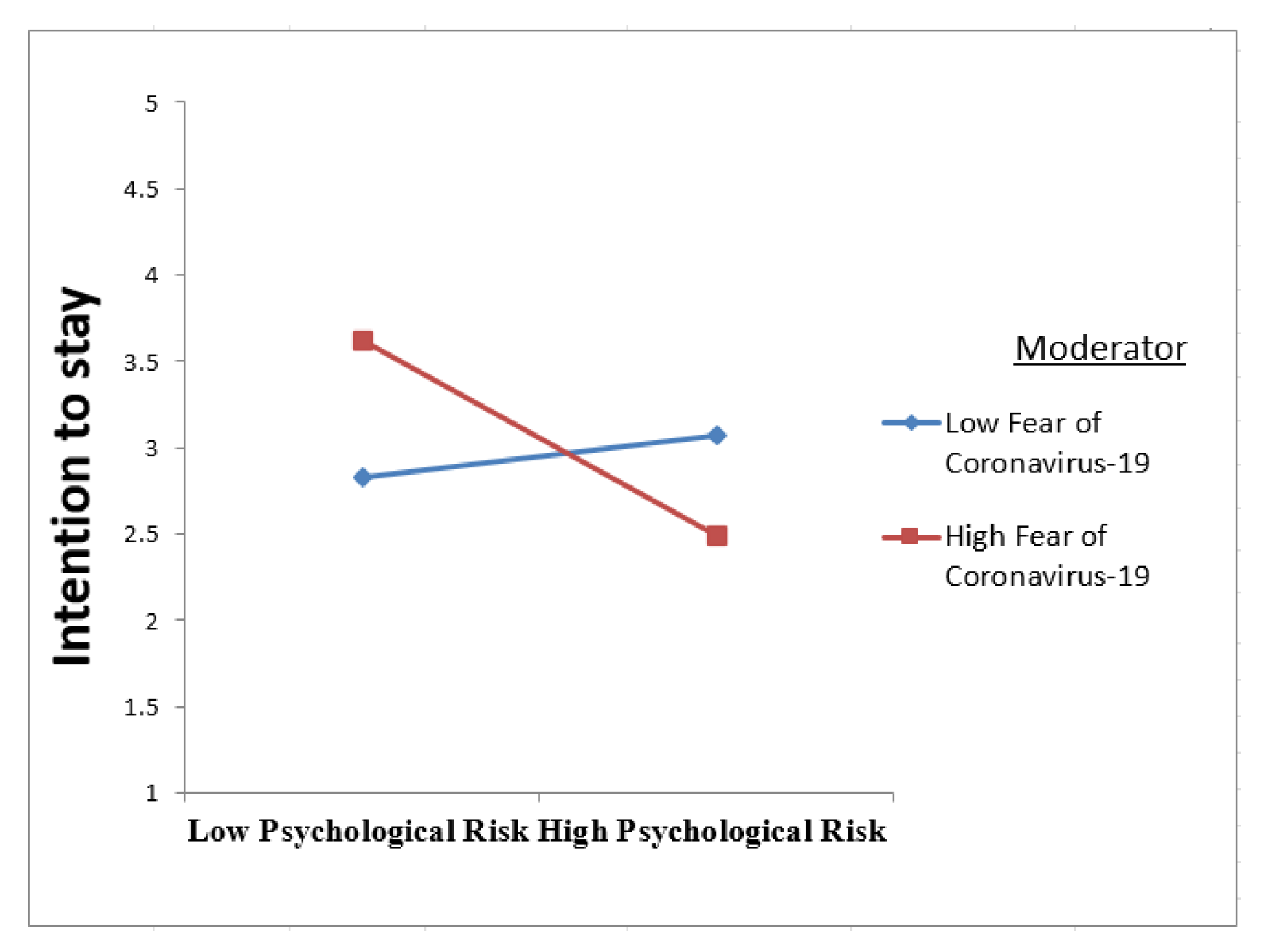
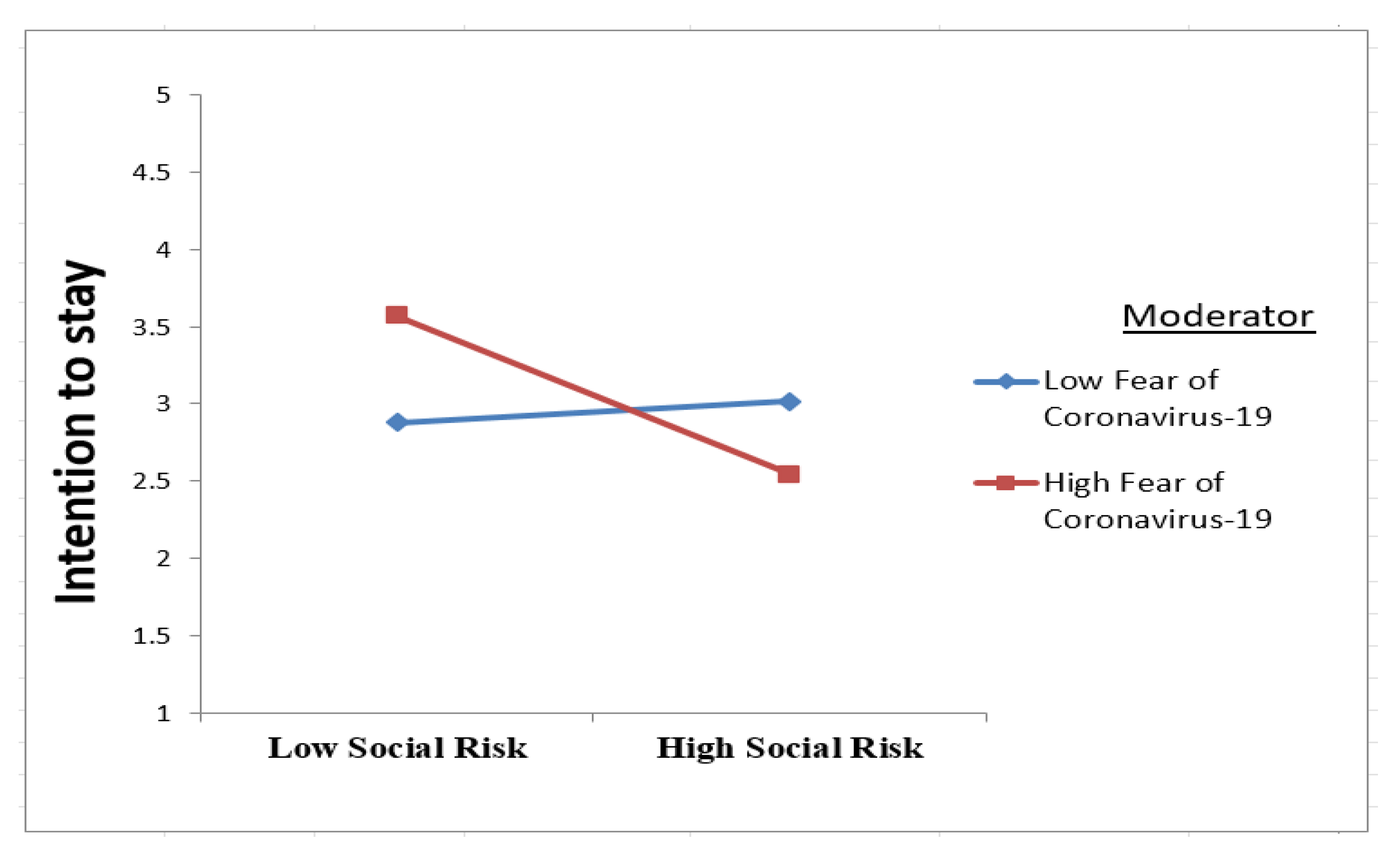
| The Model Items | Outer Loading | α | C.R | AVE |
|---|---|---|---|---|
| Performance Risk | 0.868 | 0.909 | 0.714 | |
| Perf_Risk_1 | 0.831 | |||
| Perf_Risk_2 | 0.870 | |||
| Perf_Risk_3 | 0.866 | |||
| Perf_Risk_4 | 0.811 | |||
| Financial Risk | 0.823 | 0.883 | 0.654 | |
| Fina_Risk_1 | 0.741 | |||
| Fina_Risk_2 | 0.736 | |||
| Fina_Risk_3 | 0.876 | |||
| Fina_Risk_4 | 0.871 | |||
| Physical Risk | 0.860 | 0.912 | 0.776 | |
| Physical_Risk_1 | 0.814 | |||
| Physical_Risk_2 | 0.928 | |||
| Physical_Risk_3 | 0.897 | |||
| Social Risk | 0.774 | 0.869 | 0.689 | |
| Social_Risk_1 | 0.754 | |||
| Social_Risk_2 | 0.899 | |||
| Social_Risk_3 | 0.831 | |||
| Time Risk | 0.917 | 0.932 | 0.775 | |
| Time_Risk_1 | 0.933 | |||
| Time_Risk_2 | 0.950 | |||
| Time_Risk_3 | 0.846 | |||
| Time_Risk_4 | 0.782 | |||
| Psychological Risk | 0.928 | 0.953 | 0.872 | |
| Psyc_Risk_1 | 0.931 | |||
| Psyc_Risk_2 | 0.951 | |||
| Psyc_Risk_3 | 0.919 | |||
| Intention to stay | 0.901 | 0.938 | 0.834 | |
| Inte_Stay_1 | 0.938 | |||
| Inte_Stay_2 | 0.941 | |||
| Inte_Stay_3 | 0.858 | |||
| Fear of COVID-19. | 0.901 | 0.920 | 0.622 | |
| Fear_Corona_1 | 0.704 | |||
| Fear_Corona_2 | 0.855 | |||
| Fear_Corona_3 | 0.791 | |||
| Fear_Corona_4 | 0.767 | |||
| Fear_Corona_5 | 0.720 | |||
| Fear_Corona_6 | 0.848 | |||
| Fear_Corona_7 | 0.820 |
| 1 | 2 | 3 | 4 | 5 | 6 | 7 | 8 | |
|---|---|---|---|---|---|---|---|---|
| Fear_Corona_1 | 0.704 | −0.128 | −0.135 | 0.093 | −0.118 | 0.002 | 0.271 | −0.018 |
| Fear_Corona_2 | 0.855 | 0.065 | −0.295 | 0.217 | 0.083 | 0.111 | 0.399 | 0.017 |
| Fear_Corona_3 | 0.791 | −0.031 | −0.169 | −0.004 | 0.143 | −0.011 | 0.330 | 0.185 |
| Fear_Corona_4 | 0.767 | 0.012 | −0.170 | −0.015 | 0.108 | 0.079 | 0.410 | 0.070 |
| Fear_Corona_5 | 0.720 | 0.040 | −0.147 | −0.055 | 0.053 | 0.014 | 0.129 | 0.104 |
| Fear_Corona_6 | 0.848 | 0.160 | −0.295 | 0.024 | 0.172 | 0.182 | 0.408 | 0.095 |
| Fear_Corona_7 | 0.820 | 0.042 | −0.135 | −0.120 | 0.190 | −0.072 | 0.255 | −0.086 |
| Fina_Risk_1 | −0.071 | 0.741 | −0.192 | 0.203 | 0.246 | −0.075 | 0.051 | 0.108 |
| Fina_Risk_2 | −0.040 | 0.736 | −0.210 | 0.069 | 0.357 | −0.098 | 0.098 | 0.098 |
| Fina_Risk_3 | 0.168 | 0.876 | −0.267 | 0.164 | 0.263 | −0.055 | 0.055 | 0.006 |
| Fina_Risk_4 | 0.068 | 0.871 | −0.260 | 0.133 | 0.292 | −0.062 | 0.080 | −0.004 |
| Inte_Stay_1 | −0.282 | −0.269 | 0.938 | −0.386 | −0.316 | −0.216 | −0.485 | −0.212 |
| Inte_Stay_2 | −0.320 | −0.279 | 0.941 | −0.378 | −0.334 | −0.225 | −0.485 | −0.324 |
| Inte_Stay_3 | −0.084 | −0.245 | 0.858 | −0.285 | −0.148 | −0.168 | −0.409 | −0.146 |
| Perf_Risk_1 | 0.075 | 0.238 | −0.227 | 0.831 | 0.085 | −0.002 | 0.247 | −0.080 |
| Perf_Risk_2 | 0.088 | 0.267 | −0.425 | 0.870 | 0.070 | −0.019 | 0.322 | 0.109 |
| Perf_Risk_3 | −0.065 | 0.033 | −0.293 | 0.866 | 0.004 | −0.032 | 0.176 | 0.015 |
| Perf_Risk_4 | 0.064 | 0.025 | −0.307 | 0.811 | −0.059 | 0.095 | 0.282 | −0.101 |
| Physical_Risk_1 | −0.144 | 0.260 | −0.186 | −0.038 | 0.814 | −0.183 | 0.086 | 0.041 |
| Physical_Risk_2 | 0.095 | 0.379 | −0.262 | −0.034 | 0.928 | −0.201 | 0.099 | 0.051 |
| Physical_Risk_3 | 0.271 | 0.294 | −0.325 | 0.114 | 0.897 | −0.156 | 0.296 | −0.083 |
| Psyc_Risk_1 | 0.043 | −0.092 | −0.211 | 0.065 | −0.146 | 0.931 | 0.357 | 0.088 |
| Psyc_Risk_2 | 0.067 | −0.036 | −0.243 | −0.019 | −0.187 | 0.951 | 0.271 | 0.189 |
| Psyc_Risk_3 | 0.142 | −0.135 | −0.163 | −0.019 | −0.241 | 0.919 | 0.306 | 0.041 |
| Social_Risk_1 | 0.443 | 0.170 | −0.334 | 0.284 | 0.388 | 0.210 | 0.754 | 0.134 |
| Social_Risk_2 | 0.352 | 0.081 | −0.462 | 0.319 | 0.180 | 0.329 | 0.899 | 0.241 |
| Social_Risk_3 | 0.283 | −0.009 | −0.450 | 0.184 | −0.007 | 0.272 | 0.831 | 0.237 |
| Time_Risk_1 | 0.075 | 0.058 | −0.271 | −0.071 | −0.057 | 0.112 | 0.259 | 0.933 |
| Time_Risk_2 | 0.075 | 0.054 | −0.289 | 0.037 | 0.029 | 0.178 | 0.258 | 0.950 |
| Time_Risk_3 | 0.041 | 0.025 | −0.070 | 0.047 | −0.059 | 0.090 | 0.125 | 0.846 |
| Time_Risk_4 | 0.025 | 0.037 | −0.087 | 0.073 | 0.061 | −0.085 | 0.133 | 0.782 |
| 1 | 2 | 3 | 4 | 5 | 6 | 7 | 8 | |
|---|---|---|---|---|---|---|---|---|
| Fear of COVID−19 | 0.788 | |||||||
| Financial Risk | 0.053 | 0.809 | ||||||
| Intention to stay | −0.268 | −0.290 | 0.913 | |||||
| Performance Risk | 0.052 | 0.174 | −0.389 | 0.845 | ||||
| Physical Risk | 0.126 | 0.355 | −0.305 | 0.030 | 0.881 | |||
| Psychological Risk | 0.084 | −0.087 | −0.225 | 0.011 | −0.200 | 0.934 | ||
| Social Risk | 0.421 | 0.087 | −0.507 | 0.312 | 0.201 | 0.331 | 0.830 | |
| Time Risk | 0.072 | 0.055 | −0.259 | 0.002 | −0.009 | 0.123 | 0.252 | 0.880 |
| 1 | 2 | 3 | 4 | 5 | 6 | 7 | 8 | |
|---|---|---|---|---|---|---|---|---|
| Fear of COVID−19 | 0.788 | |||||||
| Financial Risk | 0.053 | 0.809 | ||||||
| Intention to stay | −0.268 | −0.290 | 0.913 | |||||
| Performance Risk | 0.052 | 0.174 | −0.389 | 0.845 | ||||
| Physical Risk | 0.126 | 0.355 | −0.305 | 0.030 | 0.881 | |||
| Psychological Risk | 0.084 | −0.087 | −0.225 | 0.011 | −0.200 | 0.934 | ||
| Social Risk | 0.421 | 0.087 | −0.507 | 0.312 | 0.201 | 0.331 | 0.830 | |
| Time Risk | 0.072 | 0.055 | −0.259 | 0.002 | −0.009 | 0.123 | 0.252 | 0.880 |
| Endogenous Latent Construct | (R2) | (Q2) |
|---|---|---|
| Intention to stay | 0.585 | 0.440 |
| Beta (β) | t-Values | p-Values | Results | ||
|---|---|---|---|---|---|
| H1 | Financial Risk → Intention to stay | −0.172 | 4.181 | 0.000 | Accepted |
| H2 | Performance Risk → Intention to stay | −0.137 | 2.475 | 0.014 | Accepted |
| H3 | Physical Risk → Intention to stay | −0.202 | 3.545 | 0.000 | Accepted |
| H4 | Psychological Risk → Intention to stay | −0.220 | 3.445 | 0.001 | Accepted |
| H5 | Social Risk → Intention to stay | −0.222 | 3.424 | 0.001 | Accepted |
| H6 | Time Risk → Intention to stay | −0.139 | 2.222 | 0.027 | Accepted |
| H7 | Moderating Effect 1(Financial Risk × Fear of COVID-19) → Intention to stay | 0.006 | 0.098 | 0.922 | Not Accepted |
| H8 | Moderating Effect 2 (Performance Risk × Fear of COVID-19) → Intention to stay | 0.345 | 5.575 | 0.000 | Not Accepted |
| H9 | Moderating Effect 3 (Physical Risk × Fear of COVID-19) → Intention to stay | −0.186 | 2.983 | 0.003 | Accepted |
| H10 | Moderating Effect 4 (Psychological Risk × Fear of COVID-19) → Intention to stay | −0.343 | 3.648 | 0.000 | Accepted |
| H11 | Moderating Effect 5 (Social Risk × Fear of COVID-19) → Intention to stay | −0.291 | 3.735 | 0.000 | Accepted |
| H12 | Moderating Effect 6 (Time Risk × Fear of COVID-19) → Intention to stay | 0.223 | 2.472 | 0.014 | Not Accepted |
Disclaimer/Publisher’s Note: The statements, opinions and data contained in all publications are solely those of the individual author(s) and contributor(s) and not of MDPI and/or the editor(s). MDPI and/or the editor(s) disclaim responsibility for any injury to people or property resulting from any ideas, methods, instructions or products referred to in the content. |
© 2023 by the authors. Licensee MDPI, Basel, Switzerland. This article is an open access article distributed under the terms and conditions of the Creative Commons Attribution (CC BY) license (https://creativecommons.org/licenses/by/4.0/).
Share and Cite
Agina, M.F.; Aliane, N.; Sawy, O.E.; Khairy, H.A.; Fayyad, S. Risks in Relation to Adopting Airbnb Accommodation: The Role of Fear of COVID-19. Sustainability 2023, 15, 5050. https://doi.org/10.3390/su15065050
Agina MF, Aliane N, Sawy OE, Khairy HA, Fayyad S. Risks in Relation to Adopting Airbnb Accommodation: The Role of Fear of COVID-19. Sustainability. 2023; 15(6):5050. https://doi.org/10.3390/su15065050
Chicago/Turabian StyleAgina, Mohamed Fathy, Nadir Aliane, Osman El Sawy, Hazem Ahmed Khairy, and Sameh Fayyad. 2023. "Risks in Relation to Adopting Airbnb Accommodation: The Role of Fear of COVID-19" Sustainability 15, no. 6: 5050. https://doi.org/10.3390/su15065050
APA StyleAgina, M. F., Aliane, N., Sawy, O. E., Khairy, H. A., & Fayyad, S. (2023). Risks in Relation to Adopting Airbnb Accommodation: The Role of Fear of COVID-19. Sustainability, 15(6), 5050. https://doi.org/10.3390/su15065050










